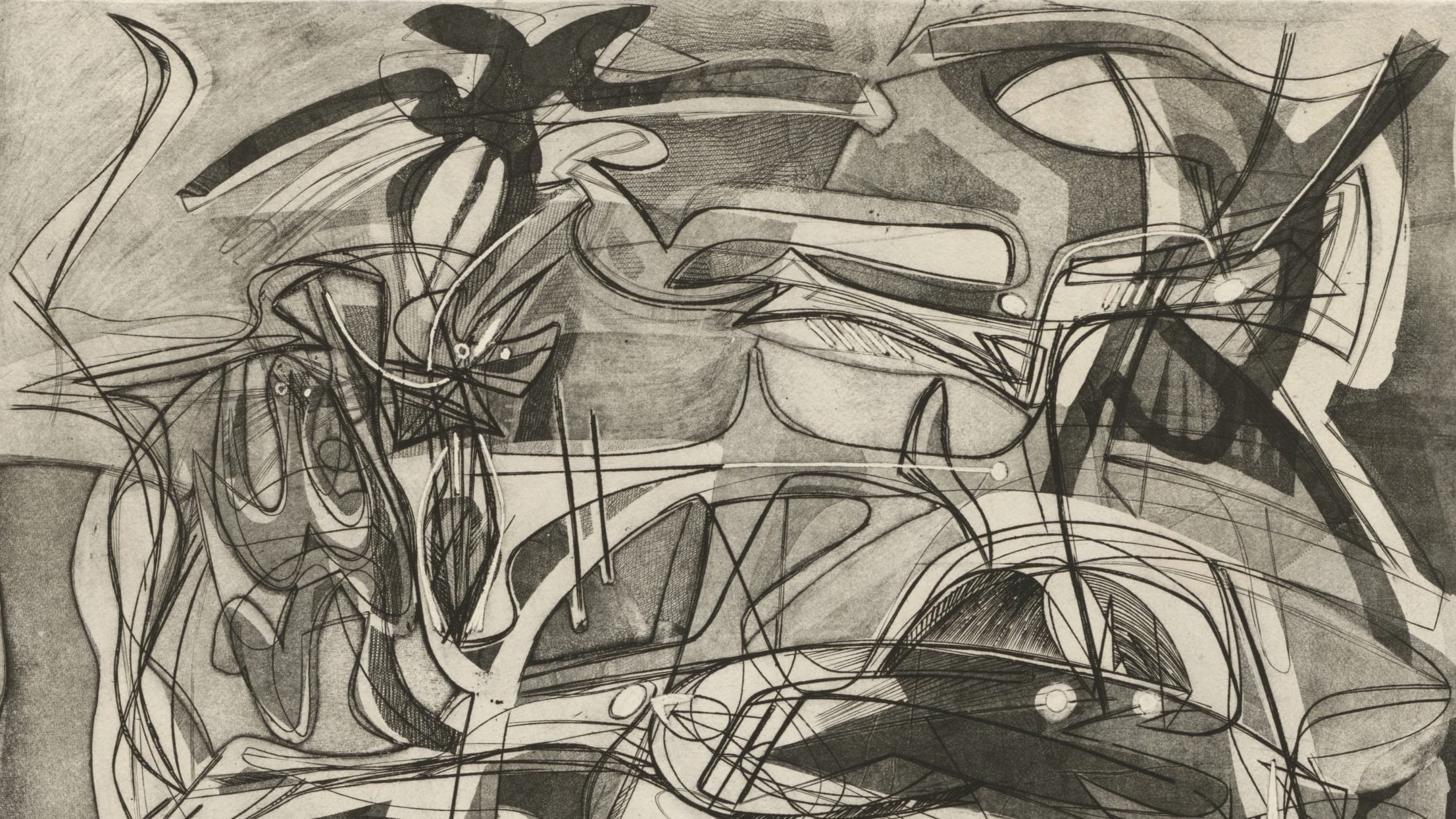
A Constellation of Centennial Projects
The centennial presents an opportune moment to reflect upon Atelier 17’s expansive reach as an important, international center of modernist activity.
The Atelier 17 Project seeks to partner with the arts community to develop a variety of projects that offer fresh perspectives about Atelier 17 and its members.
We seek to spotlight the full spectrum of artists affiliated with the workshop. Traditionally, a handful of white male artists associated with surrealism and abstract expressionism have been central to histories of Atelier 17.
Peter Grippe and David Porter at Atelier 17, ca. 1950s. Photo by Worden Day.
How to get involved?
Plan an exhibition
Spotlight a printmaker in depth or a network of artists. Highlight another unique facet of the studio.
Research and Write
Dive into the archives and learn something new!
Host an Event
Lead a workshop about engraving. Convene a scholarly event.
Wildcard!
Teach a course. Conduct an oral history. Make a print. Host a reunion.
Have an idea? Get in touch!
Please contact us if you have a project idea for the centennial. We welcome questions and conversations, and we have research tidbits to share about many of the topics below.
Potential Areas of Inquiry
The possibilities to celebrate Atelier 17 are extensive and adaptable/responsive to particular institutional holdings and archival collections. Potential areas of inquiry include (but certainly are not limited to) the following:
Artist-focused studies
Stanley William Hayter, founder of Atelier 17. Projects could focus on his artwork (prints and/or paintings), his relationship to modernism as it unfolded through his networks in Paris, London, and New York, or his extensive writings about the theory of line and the history of printmaking.
Investigations of the lasting social and professional networks that formed among members of Atelier 17. Some were based on shared ideologies and stylistic choices, while others were guided by an interest in technical inquiry.
Projects about any of the 1,000+ artists who were members of Atelier 17.
Global Considerations
International cultural exchange including, but not limited to, artists who came to Atelier 17 from Japan, China, South Korea, India, Australia, and countries in Latin America. What experiences did artists bring to Atelier 17? What did they take away?
The spread of the studio’s pedagogy across the United States and internationally, perhaps mapping hubs—such as Gabor Peterdi at Yale, Mauricio Lasansky at the University of Iowa, or Fred Becker at Washington University in St. Louis—or visualizing a “family tree” with digital humanities tools
In an era rife with dislocations, the implications of gender, race, nationality, and religion as artists worked at Atelier 17.
Stanley William Hayter at Atelier 17 in Paris, ca. 1935. Courtesy Joan Peterdi.
Technical experimentation and research at Atelier 17
The revival of engraving as a creative medium.
The generative connections between printmaking and sculpture, including cut plates, gaufrage (deeply engraved markings made with a scorper), and frottage (rubbing from found objects).
The workshop’s investigation of “plaster prints” and/or how this practice relates to the history of gypsum prints or artists currently using the practice today.
Technical innovations, including the development of simultaneous color printmaking and experimentation with soft ground etching and sugar lift.
The exploration of photogram techniques among artists and photographers who visited Atelier 17.
Fred Becker, Father, Mother & Child, 1948. Soft-ground etching & stencil, sheet: 20 x 13" each. Courtesy Dolan/Maxwell, Philadelphia.
Intermediality and crossdisciplinarity activity
Collaborations between poets and writers in Atelier 17 portfolios such as Fraternity, Solidarité, or 21 Etchings and Poems plus many others published by individual artist members.
Hayter’s work with faculty at the New School for Social Research (Max Wertheimer and Rudolf Arnheim) related to the field of visual perception.
The visualization of sound, music, dance, and rhythm in prints by Atelier 17 artists.
Stylistic concerns
Atelier 17 as a hub of Surrealism in interwar Paris and midcentury New York.
The studio’s importance to the development of postwar abstraction and expressionism in New York and Paris.
Atelier 17’s relationship to other modernist and avant-garde movements, such the School of Paris (École de Paris) and return to order (rappel à l’ordre), postwar tachisme and lyrical abstraction, Gutai, pop art, op art, and conceptualism
Politics
The engagement of Atelier 17 members with political causes, such as the Spanish Civil War or the student protests of 1968
Helen Phillips (artist) and André Verdet (poet), plate 14 from 21 Etchings and Poems, 1951-1960. Color engraving (trial proof), 13 ¾ x 11 ¾ in. Courtesy Dolan/Maxwell, Philadelphia.
Historiography
Why has Atelier 17 not been included in mainstream histories of twentieth-century modernism?
How does Atelier 17 stand historically in relation to other printmaking studios, such as Universal Limited Art Editions, Robert Blackburn Printmaking Workshop, and Pratt Graphic Art Center? What was its influence on these formative later institutions, such as Kala Art Institute?
Market and museum histories
The importance of international printmaking annuals (and biennials) to members of Atelier 17.
The network of museum curators who championed the experimental prints from Atelier 17.
The role of commercial galleries in exhibiting modernist prints and supporting members of Atelier 17.
Snapshots from 1978 party at Krishna Reddy’s studio in honor of Stanley William Hayter. Top row: Sue Fuller, Robert Blackburn, Louise Bourgeois, Worden Day, unknown. Bottom row: Minna Citron, Krishna Reddy, Sue Fuller, unknown, Stanley William Hayter.




